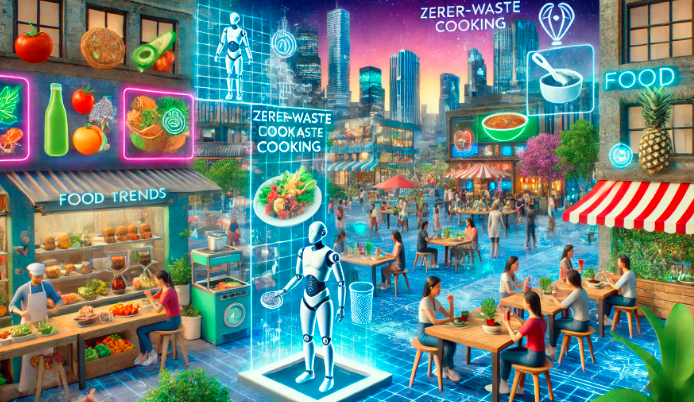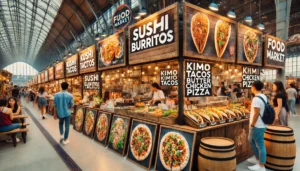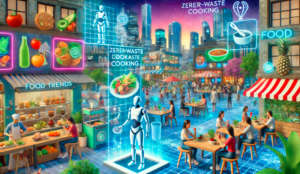Online Food Trends JalbiteBlog: A Comprehensive Guide
Introduction
In today’s digital world, food trends evolve rapidly, shaped by technology, cultural fusion, and consumer preferences. One of the leading sources highlighting these transformations is JalbiteBlog, a platform dedicated to exploring innovative culinary movements. In collaboration with JustALittleBite, it presents insights into how food habits are changing, emphasizing sustainability, global flavors, and digital transformation in the culinary space.
Online food trends have drastically changed the way people cook, eat, and engage with food content. From plant-based alternatives to AI-driven personalized nutrition, the food industry has embraced the digital era. JalbiteBlog covers the most exciting and transformative trends that are influencing the food world today.
Global Fusion Cuisines: A Taste of the World
Cultural boundaries in food are blurring, giving rise to fusion cuisines that combine flavors and techniques from different parts of the world. Some of the most popular fusion food trends include:
1. Asian-Latin Fusion
The blend of Asian and Latin American flavors has become one of the most sought-after food trends. Dishes like kimchi tacos, sushi burritos, and teriyaki-style empanadas showcase the creativity that arises from this mix.
2. Middle Eastern & Mediterranean Mashups
With the increasing popularity of hummus, tahini, and shawarma, these flavors are being infused into various global dishes. Restaurants are now experimenting with falafel burgers, pita tacos, and spiced lamb pizza.
3. African & Caribbean Flavor Integrations
Bold, spicy flavors from African and Caribbean cuisines are making their way into mainstream food trends. Jollof rice-stuffed burritos, jerk chicken sushi, and plantain-based dishes are becoming widely popular.
Tech-Driven Culinary Experiences
Technology has revolutionized the way people cook and consume food. With innovations in AI and smart kitchen appliances, the food industry has entered a new digital age.
- AI-Powered Meal Planning: Personalized nutrition plans based on dietary preferences and health goals are now more accessible than ever.
- Smart Kitchen Appliances: Devices like smart ovens, air fryers, and voice-activated recipe assistants help streamline cooking experiences.
- Virtual Cooking Classes: People are now learning to cook via online masterclasses, which allow direct interaction with chefs worldwide.
Sustainable and Zero-Waste Practices
Sustainability is no longer an option but a necessity in the food industry. Consumers and businesses alike are focusing on eco-friendly and zero-waste food practices.
| Sustainable Practices | Benefits |
|---|---|
| Eco-friendly packaging | Reduces plastic waste |
| Zero-waste cooking techniques | Maximizes food usage |
| Locally sourced ingredients | Supports small businesses and lowers carbon footprint |
| Regenerative agriculture | Enhances soil health and biodiversity |
Health-Conscious Eating
Consumers are increasingly prioritizing health and wellness in their food choices. This shift has led to a surge in demand for nutrient-dense, plant-based, and functional foods.
- Rise of Plant-Based Alternatives: The popularity of vegan meats, dairy-free cheeses, and nut-based milks continues to grow.
- Incorporation of Superfoods: Ingredients like matcha, turmeric, spirulina, and chia seeds are now staples in everyday meals.
- Reduction of Processed Foods: Consumers are moving away from ultra-processed foods, opting for fresh, organic, and homemade meals.
Revival and Reinvention of Traditional Recipes
While modern innovations dominate the food industry, traditional recipes are also making a comeback—often with a modern twist.
- Classic Dishes with a Modern Touch: Time-honored recipes are being reinvented with healthier ingredients or fusion flavors.
- Preserving Culinary Heritage: Social media platforms and blogs like JalbiteBlog help keep traditional recipes alive by sharing their history and preparation methods.
- Fusion of Old and New: Combining age-old fermentation techniques with new-age ingredients has led to creative recipes like probiotic-infused kimchi tacos and gluten-free sourdough.
Influence of Social Media on Cooking Habits
Social media platforms like TikTok, Instagram, and YouTube have revolutionized the way people discover and engage with food.
- Viral Food Trends: From whipped coffee (Dalgona) to pasta chips, social media is a driving force behind food trends.
- Freestyle Cooking: More home cooks are experimenting with recipes, encouraged by easy-to-follow online tutorials.
- Community Engagement: Platforms allow food lovers to share recipes, participate in cooking challenges, and explore global cuisines from their kitchens.
Conclusion
The online food industry is constantly evolving, with new trends shaping the way people eat and interact with food. JalbiteBlog, in collaboration with JustALittleBite, continues to spotlight the latest and most innovative culinary movements, ensuring food enthusiasts stay ahead of the curve.
As technology, sustainability, and social media redefine our food culture, embracing these changes can lead to a more conscious, creative, and exciting dining experience. Keep following JalbiteBlog for the latest updates on online food trends and discover what’s next in the ever-changing world of food!
Related Articles
The Ultimate Guide to the Triumph Tiger 900 Tail Box
The Ultimate Guide to Botox Schampoo Bestest Produkt Heklong
Wanderer Cat Plush Series: The Ultimate Guide for Collectors and Fans
MUZiiKA Guitar Pick Bracelet: A Comprehensive Guide for Musicians
































Post Comment